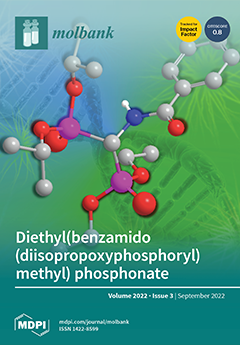A synthesis of a cationic moiety and fluorescent moieties containing amphiphilic 1,4-dihydropyridine (1,4-DHP) derivatives was performed starting with the Hantzsch-type cyclization of dodecyl acetoacetate, phenylaldehyde and ammonium acetate. Bromination of the 2,6-dimethyl groups of a parent 1,4-DHP compound, followed by nucleophilic substitution of
[...] Read more.
A synthesis of a cationic moiety and fluorescent moieties containing amphiphilic 1,4-dihydropyridine (1,4-DHP) derivatives was performed starting with the Hantzsch-type cyclization of dodecyl acetoacetate, phenylaldehyde and ammonium acetate. Bromination of the 2,6-dimethyl groups of a parent 1,4-DHP compound, followed by nucleophilic substitution of bromine with 4-(anthracen-9-yl)pyridine, produced the desired 1,1′-{[3,5-bis((dodecyloxycarbonyl)-4-phenyl-1,4-dihydropyridine-2,6-diyl]bis(methylene)}bis[4-(anthracen-9-yl)pyridin-1-ium] dibromide. The obtained target compound was fully characterized by the IR,
1H NMR,
13C NMR and HRMS data. Studies of the self-assembling properties and characterization of the nanoparticles obtained by the ethanol injection method were performed using dynamic light scattering (DLS) measurements. DLS measurement data showed that 1,1′-{[3,5-bis((dodecyloxycarbonyl)-4-phenyl-1,4-dihydropyridine-2,6-diyl]bis(methylene)}bis[4-(anthracen-9-yl)pyridin-1-ium] dibromide produced liposomes that had average diameters of 200 nm when the samples were freshly prepared, and 140 nm after 7 days or 1 month storage. The PDI values of the samples were approximately 0.50 and their zeta-potential values were approximately 41 mV when the samples were freshly prepared, and 33 mV after storage. The obtained nanoparticles were stored at room temperature for one month and remained stable during that period. The mean molecular area of the cationic 1,4-DHP-anthracene hybrid
4 was 118 Å
2, while the mean molecular area of the cationic 1,4-DHP
5 without anthracene substituents was only 83 Å
2. The photoluminescence quantum yield (PLQY) value for the EtOH solution of the 1,4-DHP derivative
4 was 10.8%, but for the 1,4-DHP derivative
5 it was only 1.8%. These types of compounds could be used as synthetic lipids in the further development of prospective theranostic delivery systems.
Full article





